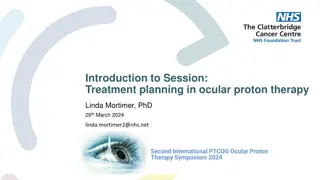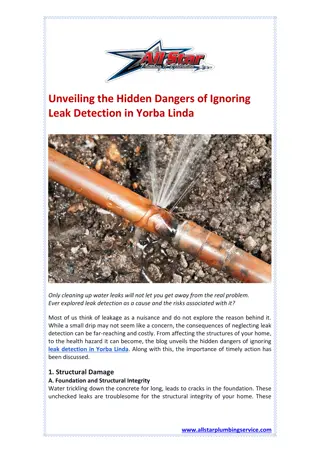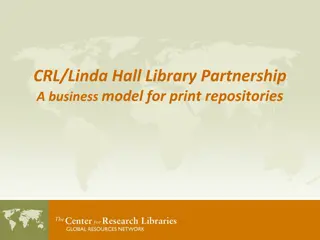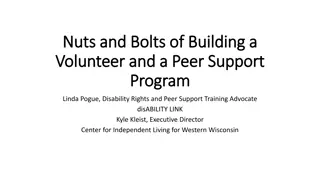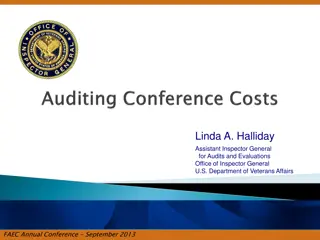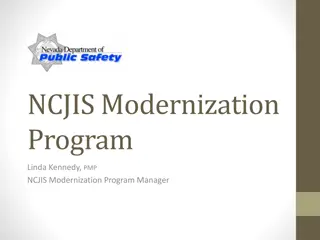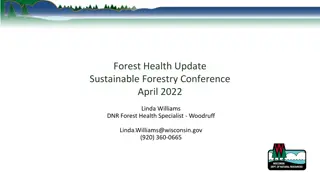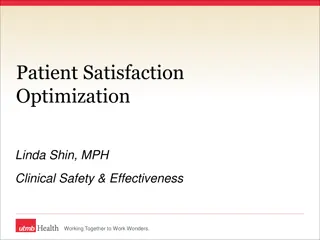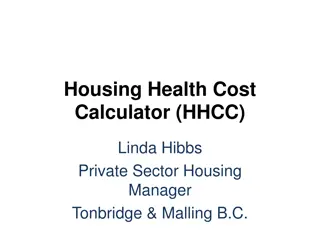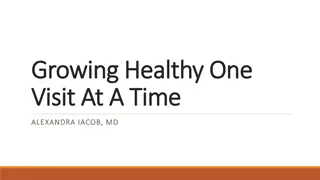MS.DEBBY LINDA
Patients at risk of pressure ulcers include those with advanced age, immobility, poor skin hygiene, excess massage, skin moisture issues, and poor nutrition. Factors contributing to pressure ulcers are discussed, such as age-related skin changes, immobility, lack of skin hygiene maintenance, excess pressure on skin, and exposure to moisture. Strategies to improve circulation, facilitate healing, prevent infections, avoid further damage, and treat bedsores are essential for managing pressure ulcers. Symptoms of pressure ulcers include redness, itching, pain, dry or rough skin, swelling, warmth, and sometimes discharge. Certain patient populations are at higher risk, including those with long-term illnesses, fractures, spinal injuries, paralysis, circulatory issues, obesity, edema, incontinence, and diabetes.
Download Presentation

Please find below an Image/Link to download the presentation.
The content on the website is provided AS IS for your information and personal use only. It may not be sold, licensed, or shared on other websites without obtaining consent from the author.If you encounter any issues during the download, it is possible that the publisher has removed the file from their server.
You are allowed to download the files provided on this website for personal or commercial use, subject to the condition that they are used lawfully. All files are the property of their respective owners.
The content on the website is provided AS IS for your information and personal use only. It may not be sold, licensed, or shared on other websites without obtaining consent from the author.
E N D
Presentation Transcript
Old age Immobility Poor skin hygiene Excess Massage Bedsheets Skin moisture Poor nutrition
Old age- Patient with advanced age are more prone to develop pressure ulcer due to poor skin integrity /loosening of skin elasticity Immobility-Bedridden patients ,pts with hemiplegia ,paraplegia etc Poor Skin hygiene-Due to lack of maintaining skin hygiene Excess Massage- Excess massage to reddened areas also lead to the formation of pressure ulcers Bed sheets-Wrinkled or wet bed sheets contribute to the development of pressure ulcers
Skin moisture- Skin exposure to moisture through in continence, perspiration or wound drainage can contribute to rashes, cracking of the skin /infection Poor Nutrition- Poor nutrtion can contribute to the development of pressure ulcers.
To improve circulation To facilitate healing To prevent infection To prevent further damage To treat bedsores
Redness of skin area Itching Pain at the site Dry or Rough skin Swelling anywhere in the skin Warmth Sometimes discharge also occurs
Patient with long term illness, fracture patients Patient with spinal injury Paralysis and limited movements Elderly with circulatory problems Obese and edematous patients Patients with incontinence Diabetic patients with ulcers
Once a pressure ulcer has developed,it can rapidly get worse unless we take quick action to treat it. There are four stages of pressure ulcers It is very important to recognize and identify the sign and symptoms of pressure ulcers at each stage.
Skin is intact and un broken Skin with non blanchable redness of a localised area usually over a bony prominence Patients complain of pain and discomfort at the site. Affects upper layer of skin ie: epidermis
Partial thickness skin loss that involves the epidermis or dermis (or both) Dermis presenting as a shallow open ulcer with a red pink wound bed without slough. Some time blister formation also occur.
Full thickness skin loss that extends into the subcutaneous tissue ( below the skin) Full subcutaneous fat may be visible but bone, tendon or muscles are not exposed.
Full thickness loss with exposed bone, tendon or muscle Exposed bone, tendon are usually directly visible /palpable The skin has turned black and shows signs of infection- red edges, pus, odor ,heat and / drainage
Redness of skin areas Itching Pain at site, soft and warmer/cooler compared with surrounding skin Dry or rough skin Swelling anywhere in the skin Warmth Sometimes discharge also occurs at the site Infected wound may often smell.
Prevention is the key treatment of pressure ulcer Pressure ulcers are preventable in nature by taking small effort by caregivers for their own patient
Skin Assesment Repositioning Techniques Skin hygiene and moisture control Pressure point care Use of proper pressure relieving devices Range of motion exercises Nutritional balance
Inspect all of the skin while repositioning the patient Clean the skin promptly after the patient pass urine or stool Avoid positioning an individual in an area of redness Avoid rubbing or massaging skin too hard- especially over the bony prominences Pat the skin dry with a soft towel Keep the skin clean and dry
Asses Specific vulnerable pressure points such as: Supine : Occipit, Sacrum,heels, shoulder Sitting : Ischial tuberosities, Coccyx Side lying position: Trochanters
There are several tools for assesing the risk for developing pressure ulcers Prevention and treatment of pressure ulcers are major nursing priorities. Various assesment scales are used such as Norton scale Braden scale Mclaren scale. Most commonly used are Norton scale and Braden scale. Each scale has five or six factors that are ranked by number.
This is the first scale reported in 1962 It scores five risk factors Physical condition Mental condition Activity Mobility Incontinence
>18 - Low Risk Between 18 and 14- Medium Risk Between 14 & 10 - High Risk < 10 - Very High risk
Braden scale was developed in 1987 It composed of six components- sensory perception, moisture, activity, mobility ,nutrition, friction and shear The total score ranges from 6-23 ,a lower scale indicates the higher chances of developing of pressure ulcers.
Very high risk: Total score 9 or less High risk :Total score 10-12 Moderate Risk :Total score 13-14 Low risk : Total score 15-16 No Risk :Total Score 19-23
The repositioning techniques are the simple and best method to prevent the occurrence of pressure ulcers. While doing repositioning remember to keep in mind some important measures to prevent further damage to the skin.
Encourage the patient independence whenever possible to change their position by their own. Keep 2-3 pillows ,towels, and protective devices nearby and use these items appropriately to protect high risk areas Make sure the patient is comfortable after turning or repositioning.
Leave a patient in an upright sitting position for long periods. This can create shearing forces Let a patient s feet rest directly against an unpadded footboard. Accidently touch an existing sore or high risk area during movement Leave a bedpan in position for long period. The pressure could cause pressure sore within minutes
For sitting position in bed head of bed should not be >30 For bedridden patient ,it should be an oblique position inclined at 30 degree. Use of 2-3 pillows is required to release the pressure from bony prominences. Schedule regular and frequent turning and positioning at least every 2 hrs and one hourly in elderly patients. Encourage the patient to move in bed as far as possible.
Inspection Absorb moisture Skin cleansing Minimize irritation and dryness Skin hygiene Avoid dry skin Avoid massage Minimize Exposure to moisture Health teaching Use of diaper Bedsheet
Pillows Cotton rings Air mattresses
Mobility is the key factor in determining activities and exercise level. The basic objective is to prevent stiff joints, muscle weakness, and to release the pressure from the pressure points. The exercises are : Neck and head exercise Ankle pump exercise Knee raised exercise Elbow exercise
It includes the relieving of pressure from highly vulnerable areas with the help of comfort devices or ROM Exercises
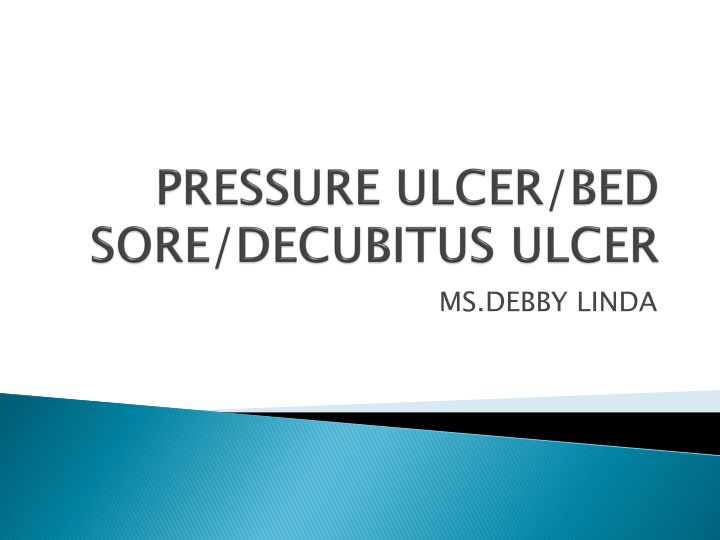

![get⚡[PDF]❤ The Healthiest People on Earth: Your Guide to Living 10 Years Longer](/thumb/20470/get-pdf-the-healthiest-people-on-earth-your-guide-to-living-10-years-longer.jpg)
